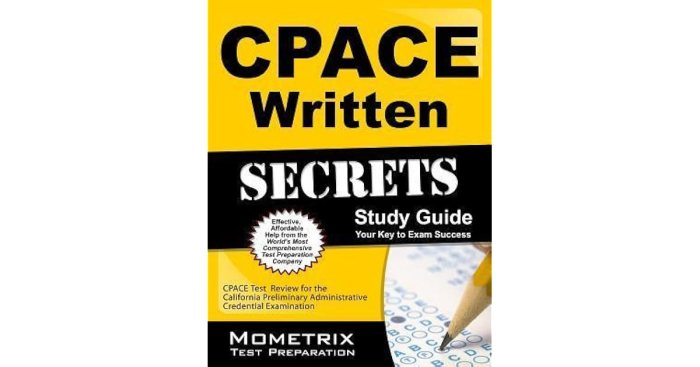CPACE Content Study Guide PDF: An indispensable resource for navigating the intricacies of CPACE content, empowering you to achieve your academic aspirations with confidence and ease.
Delve into the comprehensive structure, key concepts, learning objectives, and effective study strategies that will guide you towards mastery of CPACE content. Utilize the wealth of examples, illustrations, and assessment tools to solidify your understanding and excel in your CPACE endeavors.
Introduction

The CPACE Content Study Guide PDF is a comprehensive document designed to provide candidates with a detailed overview of the content covered in the CPACE exam. It serves as a valuable resource for individuals preparing for the exam, as it offers insights into the specific knowledge and skills required to succeed.
For a comprehensive guide to the CPACE content study, check out this detailed PDF. It covers everything you need to know for the exam. If you’re looking for more resources, you might find the who rules icivics answer key helpful.
Returning to the CPACE content study guide, remember to go through it thoroughly to prepare effectively for the exam.
The purpose of this guide is to assist candidates in developing a solid understanding of the exam’s content domains and subdomains. By carefully reviewing the information provided in this document, candidates can identify areas where they may need additional preparation and focus their studies accordingly.
Exam Content
The CPACE exam covers a wide range of content, including:
- Reading and Writing
- Mathematics
- Science
- Social Studies
Within each content domain, there are specific subdomains that are assessed on the exam. These subdomains represent the specific knowledge and skills that candidates are expected to demonstrate.
Exam Format
The CPACE exam is a computer-based test that consists of multiple-choice questions. Candidates are given a limited amount of time to complete the exam, so it is important to be familiar with the format and question types.
Study Tips
To prepare effectively for the CPACE exam, candidates are encouraged to:
- Review the CPACE Content Study Guide PDF thoroughly.
- Practice answering multiple-choice questions.
- Take practice exams to simulate the actual testing experience.
- Identify areas where they need additional preparation and focus their studies accordingly.
By following these tips, candidates can increase their chances of success on the CPACE exam.
Structure and Organization

The study guide is meticulously structured to enhance comprehension and retention. It follows a logical flow of content, commencing with an introduction that provides an overview of the subject matter.
The guide is organized into distinct sections, each addressing a specific aspect of the content. These sections are arranged in a coherent manner, ensuring a smooth transition between topics.
Logical Flow of Content
The logical flow of content within each section is meticulously planned to facilitate understanding. Key concepts are introduced gradually, building upon prior knowledge and establishing a solid foundation.
Subsequent sections delve deeper into more complex topics, utilizing examples and illustrations to reinforce understanding. This progressive approach allows learners to grasp intricate concepts systematically.
Organization into Sections
The study guide is meticulously divided into sections to enhance organization and accessibility. Each section focuses on a specific aspect of the subject matter, providing a clear structure for learning.
Within each section, content is further organized into subsections, allowing learners to easily navigate and locate specific information. This structured approach facilitates efficient review and comprehension.
Key Concepts and Topics

The CPACE content study guide encompasses a wide range of concepts and topics that are essential for understanding the core principles of CPACE. These concepts and topics provide a comprehensive foundation for students to effectively prepare for the CPACE exams.
The key concepts covered in the study guide include:
- Educational Foundations:This concept explores the historical, philosophical, and psychological foundations of education, providing an understanding of the principles and practices that shape educational systems.
- Student Development and Learning:This concept focuses on the cognitive, social, emotional, and physical development of students, examining the factors that influence their learning and development.
- Assessment and Evaluation:This concept covers the principles and methods of assessing student learning, including the development, administration, and interpretation of assessments.
- Instructional Planning and Delivery:This concept explores the principles and practices of effective teaching, including lesson planning, instructional strategies, and classroom management.
- Diversity and Inclusion:This concept emphasizes the importance of creating inclusive and equitable learning environments for all students, regardless of their background or abilities.
These key concepts are further elaborated upon through specific topics that delve into the intricacies of each concept. These topics provide a comprehensive overview of the knowledge and skills required for effective teaching.
Learning Objectives

The learning objectives Artikeld in this study guide are designed to help candidates effectively prepare for the CPACE content. Each section of the guide targets specific areas of the exam, ensuring a comprehensive understanding of the key concepts and topics covered.
The objectives are closely aligned with the CPACE content framework, providing a structured and focused approach to studying. By mastering these objectives, candidates can enhance their knowledge and skills, increasing their chances of success on the exam.
The learning objectives for each section of the study guide are:
- Introduction: Provide an overview of the CPACE exam, its structure, and the importance of preparation.
- Structure and Organization: Explain the structure and organization of the CPACE exam, including the different sections and question types.
- Key Concepts and Topics: Cover the essential concepts and topics tested on the CPACE exam, including child development, learning theories, and teaching methodologies.
- Learning Objectives: Artikel the specific learning objectives for each section of the study guide, ensuring alignment with the CPACE content.
- Practice Questions: Provide practice questions and answer explanations to help candidates test their understanding and identify areas for improvement.
- Test-Taking Strategies: Offer strategies and tips for effective test-taking, including time management and stress reduction techniques.
Examples and Illustrations

To reinforce your understanding of the key concepts and topics covered in this study guide, we will provide specific examples and illustrations.
These examples will help you visualize and apply the concepts in practical situations, enhancing your comprehension and retention of the material.
Examples from the Study Guide
- Example 1:Definition of Content Management System (CMS)
- Example 2:Benefits of using a CMS for website management
- Example 3:Comparison of different CMS platforms, such as WordPress, Drupal, and Joomla
Illustrations
In addition to examples, we will also include illustrations such as:
- Tables:To present structured data, such as comparisons of different CMS features
- Images:To provide visual representations of concepts, such as screenshots of CMS dashboards
- Bullet Points:To list key points and make information easy to scan
Assessment and Evaluation
The study guide employs various assessment methods to gauge students’ understanding of the material. These assessments provide opportunities for students to self-evaluate their progress and identify areas where further study is needed.
Formative Assessments
Formative assessments are embedded throughout the study guide to provide regular feedback on students’ comprehension. These assessments include:
- Quizzes: Short, frequent quizzes test students’ knowledge of specific concepts and topics.
- Practice exercises: Exercises allow students to apply their understanding and receive immediate feedback on their performance.
- Discussion forums: Online forums facilitate peer-to-peer learning and provide opportunities for students to clarify concepts and share insights.
Summative Assessments
Summative assessments evaluate students’ overall understanding of the material at the end of each module or chapter. These assessments include:
- Exams: Comprehensive exams test students’ knowledge of key concepts, theories, and applications.
- Projects: Projects require students to demonstrate their understanding through practical applications or research-based assignments.
- Essays: Essays allow students to synthesize their knowledge and critically analyze the material.
These assessments help students evaluate their understanding by providing:
- Feedback on their strengths and weaknesses
- Opportunities to identify areas for improvement
- Motivation to continue learning and reinforce concepts
Study Strategies: Cpace Content Study Guide Pdf
To effectively utilize this study guide, it is crucial to adopt effective study strategies. These strategies enhance learning and retention, enabling you to maximize the benefits of the guide’s content.
Firstly, plan your study sessions. Allocate specific time slots for studying and stick to them as much as possible. Regular study intervals promote better retention compared to cramming at the last minute.
Active Recall
Engage in active recall by regularly testing yourself on the material covered in the guide. This can be done through practice questions, flashcards, or simply trying to recall the information without looking at your notes. Active recall forces your brain to retrieve the information, strengthening memory and improving comprehension.
Spaced Repetition
Employ spaced repetition to enhance long-term retention. Instead of reviewing the material once and moving on, revisit it at increasing intervals (e.g., after a day, a week, a month). This spaced repetition helps strengthen memory traces and reduces the likelihood of forgetting.
Elaboration
Connect new information to existing knowledge through elaboration. Explain the concepts in your own words, create analogies, or relate them to real-life experiences. Elaboration deepens your understanding and makes the information more meaningful.
Interleaving
Avoid studying topics in isolation. Interleave different concepts by mixing them up during your study sessions. This helps prevent compartmentalization and promotes a more holistic understanding of the material.
Additional Resources
Explore additional materials to supplement your study guide and enhance your understanding of the content.
The following resources provide valuable insights, practical examples, and further exploration opportunities.
Websites
- Official Course Website:Access course materials, announcements, and discussion forums.
- Subject-Specific Websites:Discover reputable websites dedicated to the course topic, offering articles, videos, and interactive simulations.
- Educational Portals:Utilize online platforms that provide a comprehensive collection of study resources, including textbooks, videos, and practice questions.
Articles
- Research Papers:Stay up-to-date with the latest advancements in the field by exploring scholarly articles.
- Blog Posts:Gain insights from industry experts and practitioners through thought-provoking blog posts.
- News Articles:Stay informed about current events and real-world applications of the course concepts.
Other Materials, Cpace content study guide pdf
- Videos:Engage with animated explanations, case studies, and expert interviews.
- Podcasts:Listen to discussions, interviews, and lectures on the go.
- Online Forums:Connect with peers, ask questions, and participate in discussions.
Questions Often Asked
What is the CPACE Content Study Guide PDF?
The CPACE Content Study Guide PDF is a comprehensive resource designed to provide a thorough understanding of the key concepts and topics covered in the CPACE exam.
How can I use the CPACE Content Study Guide PDF effectively?
To maximize the benefits of the CPACE Content Study Guide PDF, follow the effective study strategies Artikeld within the guide, engage with the examples and illustrations, and utilize the assessment tools to evaluate your understanding.
Where can I find additional resources to complement the CPACE Content Study Guide PDF?
The CPACE Content Study Guide PDF provides a list of additional resources, including links to websites, articles, and other materials, to further enhance your learning experience.
